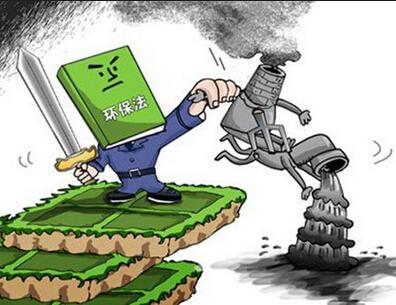According
to the 2016 legislation work plan released by the Standing Committee of the
National People's Congress, the Environmental Protection Tax Law of the
People's Republic of China is to be examined in June this year. If it goes
on smoothly, the law will be issued within this year.

Source: Baidu
This signals that the environmental protection charge (= pollutant emission charge) system will be
substituted for environmental protection tax, which is of strong
enforceability. Accordingly, the tax rate will be raised based on economic
conditions.
Specifically:
-
Tax on
air/ water pollutants: USD0.18 (RMB1.2) and USD0.21 (RMB1.4) based on
every 1 kg of pollutant equivalence
-
Tax on
solid wastes: varied from USD0.76/t (RMB5/t) to USD4.55/t (RMB30/t)
Notably, specific tax rates will be regulated by local governments.
In addition, the levitation and administration pattern will be modified, from
"self-tax collection and self-administration' by environmental protection
departments only to "applications by enterprises, and tax collection by
taxation departments' to achieve "joint administration and information
sharing'.
China's tax collection and administration pattern based on revised
environmental protection tax law, 2016
|
Item
|
Content
|
|
Application
by enterprise
|
In
regard to applications made for pollutant category and emissions by key
target taxpayers during pollutant emission monitoring:
Taxation
department in charge to submit application documents to corresponding
environmental protection department for examination and approval within 5
days from the due tax date;
Environmental
protection department in charge to offer opinions after examination to
corresponding taxation department within 30 days from the date it receives
the said documents.
|
|
Tax
collection by taxation department
|
Administration
to be carried out based on classifications, namely key target taxpayers and
non-key taxpayers during pollutant emission monitoring;
If
pollutant emission concentration > national or local standards, OR,
pollutant emission > specified total emission: tax to be doubled based on
local tax standard and to be collected
If
pollutant emission concentration > national or local standards, AND,
pollutant emission > specified total emission: tax to be tripled based on
local tax standard and to be collected
|
|
Joint
administration
|
Taxation
department could request environmental protection department to examine
pollutant emissions made by taxpayers, if it finds unrealistic data, tax
dodging, etc.
|
|
Information
sharing
|
Taxation
and environmental protection departments to establish information sharing
system
|
Source:
Ministry of Environmental Protection of the People's Republic of China

In
June 2016, the Ministry of Environmental Protection of the People's Republic of
China (MEP) solicited public opinions on the Water Pollution Prevention and
Control Law of the People's Republic of China, which is expected to have a
full-scale combination with the Environmental Protection Law of the People's
Republic of China, and meanwhile to be a complement to the environmental
protection tax law.
Accordingly, it specifies the polluting units'
responsibilities: to dispose pollutants based on certificates, to carry out
self-monitoring and keep monitoring records in accordance with laws and
regulations, to periodically make reports and unveil details, to take measures
to effectively prevent and control water pollution, and to take
responsibilities for doing harms. Specifically, it regulates that no pollutant
emission charges will be collected if the environmental protection tax is
levied.
On 1 Jan., 2015, the revised environmental protection law was officially
implemented. From then on, the Chinese government successively issued laws and
regulations related to environmental protection. This caused certain market
fluctuations.
-
Feb.
2015 - Water Pollution Prevention Action Plan ("Water Ten
Plan") issued, to carry out strong supervision on sewage treatment,
industrial water discharge, emission control, etc., and to establish
strict accountability system
-
Dec.
2015 - Measures to Assess and Cope with Environmental Monitoring Data
Deceits formulated (carried out on 1 Jan., 2016), in accordance with
the environmental protection law and the Ecological Monitoring Network
Construction Proposal, to cope with environmental monitoring data deceits
During the production of sweeteners,
wastewater of high salt/ organics contents will be produced at large
quantities, which causes great treatment difficulties. For instance, pollutants
will be brought from producing starch sugar (processes including enzymolysis,
liquefaction, saccharification and decolouring), comprehensive CODcr up to 6,500 mg/L.
However, CODcr in wastewater from main wastewater
outlets of enterprises should be 100 mg/L, for the wastewater discharge,
according to the Standard for Water
Pollutant Emission in Starch Sugar Industry (GB25461-2010).
For a long period, many enterprises
choose to "pay for pollutant emissions instead of improving pollutant
treatment', due to the high costs for process development and pollutant
treatment facilities, and the not strictly enforced laws.
The launch of environmental protection
tax will force enterprises to pay higher for pollutant emissions, which will
then push them to cope with pollutants.
Accordingly, in order to treat with
wastewater, waste gas and solid wastes during the sucralose production, JK
Sucralose Inc. has for years constructing and improving related facilities,
investment at over USD9.11 million (RMB60 million) in total. In addition, Anhui
Jinhe Industrial Co., Ltd. to date has input USD1.52 million (RMB10 million) in
its wastewater treatment project.
This article comes from Sweeteners China News 1606, CCM

About CCM:
CCM is the leading market intelligence
provider for China's agriculture, chemicals, food & ingredients and life
science markets. Founded in 2001, CCM offers a range of data and content
solutions, from price and trade data to industry newsletters and customized
market research reports. Our clients include Monsanto, DuPont, Shell, Bayer, and
Syngenta. CCM is a brand of Kcomber Inc.
For more information about CCM, please
visit www.cnchemicals.com or get in touch with us directly by emailing
econtact@cnchemicals.com or calling +86-20-37616606.
Tag: sweeteners environmental protection